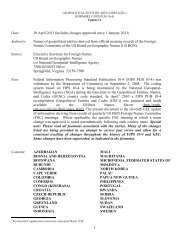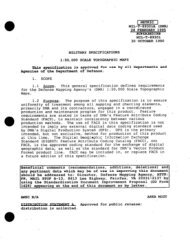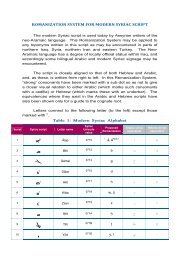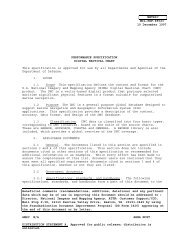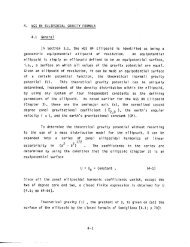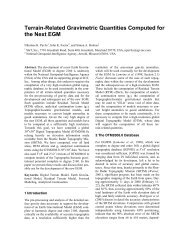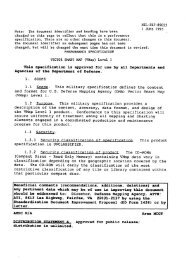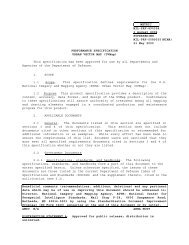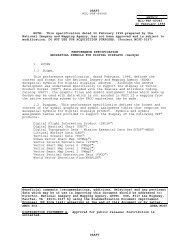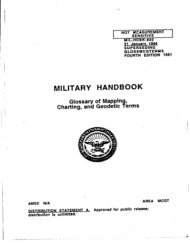ROMANIZATION SYSTEM FOR ARABIC - NGA
ROMANIZATION SYSTEM FOR ARABIC - NGA
ROMANIZATION SYSTEM FOR ARABIC - NGA
You also want an ePaper? Increase the reach of your titles
YUMPU automatically turns print PDFs into web optimized ePapers that Google loves.
<strong>ROMANIZATION</strong> <strong>SYSTEM</strong> <strong>FOR</strong> <strong>ARABIC</strong><br />
BGN/PCGN 1956 System<br />
This System was adopted by the BGN in 1946 and by the PCGN in 1956 and is applied in the<br />
systematic romanization of geographic names in Bahrain, Egypt, Iraq, Jordan, Kuwait, Libya, Oman,<br />
Qatar, Saudi Arabia, Syria, the United Arab Emirates, and Yemen.<br />
Uniform results in the romanization of Arabic are difficult to obtain, since vowel points and<br />
diacritical marks are generally omitted from both manual and machine writing. It follows that for correct<br />
identification of the words which appear in any particular name, knowledge of its standard Arabicscript<br />
spelling including proper pointing, and recognition of dialectal and idiosyncratic deviations are<br />
essential.<br />
In order to bring about uniformity in the Roman-script spelling of geographic names in Arabiclanguage<br />
areas, the system is based insofar as possible on fully pointed modern standard Arabic. In the<br />
interest of clarity, vowel pointing has been applied to the examples below. Arabic is written from right<br />
to left, and does not make a distinction between upper and lower case.<br />
1.<br />
Arabic<br />
Final Medial Initial Independent<br />
2. اـ ا<br />
ء<br />
CONSONANT CHARACTERS<br />
Romanization Examples and Remarks<br />
not romanized in<br />
word-initial position<br />
’ in all other<br />
positions<br />
not romanized in<br />
word-initial position<br />
ْلاَمَك وبأ Abū Kamāl<br />
ْتي َز ْرئ ِ ب Bi’r Zayt 2<br />
ْءاَعن َص<br />
ْدَمَعلا مأ<br />
Şan‘ā’<br />
Umm al ‘Amad 3<br />
3. بـ ـبـ ـب ب b ْني َر ْحَبلا Al Baḩrayn<br />
4. تـ ـتـ ـت ت t ْتوكلا Al Kūt<br />
5. ثـ ـثـ ـث ث th ْتاَو ُ ثي َ ل ُ ثلا Ath Thulaythuwāt<br />
6. جـ ـجـ ـج ج j ة َري ِ ز َجلا Al Jazīrah<br />
7. حـ ـحـ ـح ح ḩ ةَيدُوم ْحَملا Al Maḩmūdīyah<br />
8. خـ ـخـ ـخ خ kh ْرَبي َخ Khaybar<br />
9. دـ د d ْرُوهنَمَد Damanhūr<br />
10. ذـ ذ dh ْب َه َد Dhahab<br />
11. رـ ر r ة َضْو َرلا Ar Rawḑah<br />
12. زـ ز z ةَيوا َزلا Az Zāwīyah<br />
13. سـ سـ ـس س s ةَيناَمي َ ل ُس Sulaymānīyah<br />
14. شـ شـ ـش ش sh ْما َشلا Ash Shām<br />
15. صـ ـصـ ـص ص ş ةَمو ُصيَق Qayşūmah<br />
1
2<br />
Arabic<br />
Final Medial Initial Independent<br />
Romanization Examples and Remarks<br />
16. ضـ ـضـ ـض ض ḑ ْر ْو َض Ḑawr<br />
17. طـ ـطـ ـط ط ţ ة َر ِطيَن ُ قلا Al Qunayţirah<br />
18. ظـ ـظـ ـظ ظ z̧ ي ِ ب َ ظ وب َ أ Abū Z̧aby<br />
19. عـ ـعـ ـع ع ‘ ْ شَي ِ ر َع وب َ أ Abū ‘Arīsh<br />
20. غـ ـغـ ـغ غ gh ْداَدْغَب Baghdād<br />
21. فـ ـفـ ـف ف f ْتار ُ فلا Al Furāt<br />
22. قـ ـقـ ـق ق q ْر َ ط َق Qaţar<br />
23. كـ ـكـ ـك ك k ْتيَو ُ كلا Al Kuwayt<br />
24. لـ ـلـ ـل ل l ْب َ لَح Ḩalab<br />
25. مـ ـمـ ـم م m ة َّ ك َم Makkah<br />
26. نـ ـنـ ـن ن n ْ ل ْخ َن Nakhl<br />
27. هـ ه/ﮩ ـه ه h ْنُوراَه ْ لَب َج Jabal Hārūn<br />
28. وـ و w اض َغ يِداَو Wādī Ghaḑā<br />
29. يـ ـيـ ـي ي y ْنَمَيلا Al Yaman<br />
VOWEL CHARACTERS AND DIACRITICAL MARKS<br />
Arabic Romanization Examples and Remarks<br />
1. َ◌ a ة َر ْصَبلا Al Başrah<br />
2. ِ◌ i ْضاي ِ رلا Ar Riyāḑ<br />
3. ُ◌ u ْسْد ُ قلا Al Quds<br />
4. ا َ◌ ā ْبَدْنَملا باَب Bāb al Mandab 3<br />
5. ي ِ◌ ī ةَنيِدَملا Al Madīnah<br />
6. و ُ◌ ū ْرو ُص Şūr<br />
7. ٰى ،ى َ◌ á ْحوُر ْ طَم ٰیس ْرَم Marsá Maţrūḩ 7<br />
8. ْ◌ not romanized Indicates absence of a short vowel.<br />
9. ْي َ◌ ay ادْي َص Şaydā<br />
10. ْو َ◌ aw ة َحْوَدلا Ad Dawḩah<br />
11. ً◌ a n See note 8<br />
12. ٍ◌ i n See note 8<br />
13. ٌ◌ u n See note 8<br />
14. ّ◌ doubling of<br />
consonant letter<br />
See note 9<br />
15. ٱ ʼ See note 10<br />
16.<br />
آ<br />
ā in word-initial<br />
position<br />
ْطيَعُموُبلآ Ālbū Mu‘ayţ 3,11<br />
ʼā in word-medial<br />
position نآر ُ ق Qur’ān 3
NUMERALS<br />
1 2 3 4 5 6 7 8 9 0<br />
1 2 3 4 5 6 7 8 9 0<br />
Although Perso-Arabic script is written from right to left, numerical expressions, e.g., 1956 - 1956 are<br />
written from left to right.<br />
NOTES<br />
1. The symbol ◌ represents any Arabic consonant character.<br />
2. Hamzah (ء) is written in Arabic in association with most instances of initial alif, except those which<br />
belong to the definite article al or which bear a maddah (see note 11). Hamzah is written above<br />
the alif if the accompanying short vowel is a fatḩah ( َ أ) or ḑammah ( ُ أ) and below the alif if the<br />
accompanying short vowel is a kasrah (ِإ). When the purpose is to indicate the presence of a glottal<br />
stop, hamzah is written over medial and final alif (أ), wāw (ؤ) and yā’ without dots (ئ). Hamzah<br />
following kasrah (◌ِ ) is written (ئ). Almost always the yā’ is in the initial or medial form and the<br />
dots are omitted: example: (رئب). Hamzah following ḑammah (◌ُ )is written (ؤ). Hamzah following a<br />
long vowel is written without a bearer and is positioned on the line of print like a regular character.<br />
The romanization of hamzah (’) should always be carefully distinguished from that of ‘ayn (‘).<br />
3. Alif as such is not romanized when it is a bearer of hamzah, but see fatḩah alif (ا◌َ) and alif maddah<br />
( آ ) in the vowel table. See also note 2 and 11 above.<br />
4. In certain endings, an original tā’ (ت) is written (ة), i.e., like hā’ with two dots, and is known as tā<br />
marbūţah. It is romanized h, except in the construct form, where it is romanized t instead. Example:<br />
hamzah, hamzat al qaţ‘ . The ending fatḩah hā’ (ه◌َ) may be romanized a·h when the character hā’<br />
(ه) is not silent. Example: Muntaza·h. See also note 5.<br />
5. Occasionally, the character sequences ـهـكـ , ـهـتـ, ـهدـ and ـهس occur. They may be romanized k·h, t·h,<br />
d·h, and s·h in order to differentiate those romanizations from the digraphs kh, th, dh, and sh. See<br />
also note 4.<br />
6. Where special considerations are paramount, the sub-dot ( ִ ) may be used in place of the cedilla.<br />
7. The character yā’ (in final form but without dots) preceded by the vowel point fatḩah is a combination<br />
known as alif maqşūrah. See character 7 in the vowel table.<br />
8. The classical Arabic grammatical endings written with the nunation symbols (tanwīn) may be<br />
romanized, when necessary, by a n , i n , u n . In modern Arabic, these endings have become silent and<br />
should not be romanized: classical alifu n modern alif.<br />
9. Doubled consonant sounds are represented in Arabic script by placing a shaddah (◌ّ) over a<br />
consonant character. In romanization the letter should be doubled. However, the combination of<br />
the consonant character yā’ with a shaddah preceded by a kasrah (ــيِّــــ) is romanized īy rather than<br />
iyy. e.g., (ةـيِّـــ) is romanized (īyah) and not (iyyah).<br />
3
4<br />
When the definite article (al) precedes a word beginning with one of the “sun letters” t, th, d, dh, r,<br />
z, s, sh, ş, ḑ, ţ, z̧ , l, or n – the l is assimilated in pronunciation and romanization, thus yielding tt, thth,<br />
etc., in romanization. Example, An Nīl, not Al Nīl.<br />
10. Hamzat al waşl (ٱ), which is utilized only in the pointing of classical Arabic, is romanized ’ as<br />
illustrated in the classical form of its name hamzatu’l waşli.<br />
11. Since maddah (آ), which is placed over alif (ا), nearly always occurs in word-initial position, no<br />
confusion results from the use of ā for alif maddah (آ) as well as for fatḩah alif (اَ◌ ).<br />
12. The ligatures لا and اـل represent lām- alif, and should be romanized lā.<br />
SPECIAL RULES<br />
1. Initial definite articles and prepositions should be capitalized and hyphens should not be used to<br />
connect parts of names, e.g., Ash Shāriqah and Tall al Laḩm.<br />
2. If any evidence is found for the use of the definite article in a name, the article should be used in the<br />
name chosen.<br />
3. The Arabic word for God should be written Allāh (ﷲ).<br />
4. Names which consist of noun phrases should be written as separate words. The definite article<br />
within such names should be romanized al, not ul, e.g., ‘Abd Allāh, ‘Abd ar Raḩmān, Dhū al Faqār.<br />
5. The Arabic word نب ِshould be romanized Bin rather than Ibn whenever written without alif, that is<br />
between two proper nouns, e.g., ‘Umar Bin al Khaţţāb.<br />
6. The Turkish word Paşa should be romanized from Arabic script as Bāshā. The Turkish word Bey<br />
should be romanized as Bey in Egyptian names, no matter how it is written in Arabic-language<br />
sources, but in other Arabic areas it should be romanized as Bak where written كب and as Bayk<br />
when written كيب.<br />
7. The modern colloquial word Sīdī should be give precedence over the classical form Sayyidī. This<br />
does not preclude the spelling Sayyidī if the latter is indicated by the Arabic script or other evidence<br />
– for instance, if the yā’ is written with a shaddah (◌ّ).<br />
8. The colloquial word Bū should not be changed to the standard form Abū.<br />
9. The colloquial word for water, written ةيم on Arabic maps, should be romanized Mayyat.<br />
10. Place names of Aramaic origin in Syria often contain initial consonant clusters consisting of b
plus another consonant such as l or h. In romanization, the clusters bl, bh, etc., should be so<br />
represented.<br />
11. In names containing the Arabic word for back, ridge, or hill, appearing as either رهظ or رهض in<br />
Arabic sources, the word should be romanized to reflect the particular Arabic spelling shown.<br />
5



